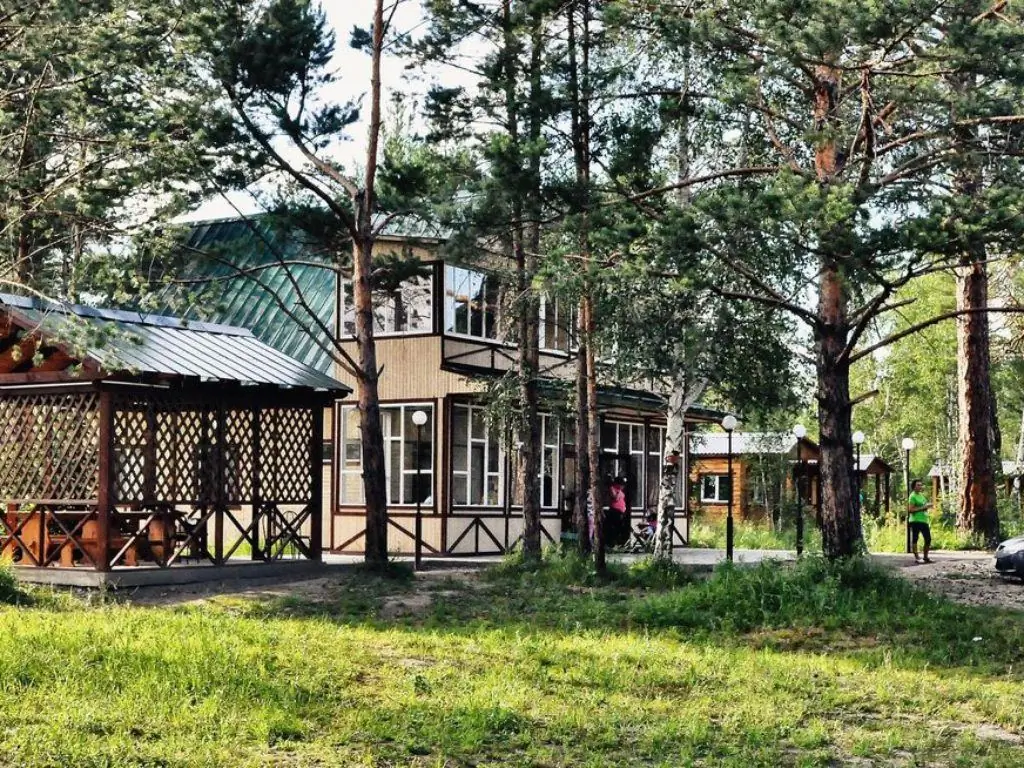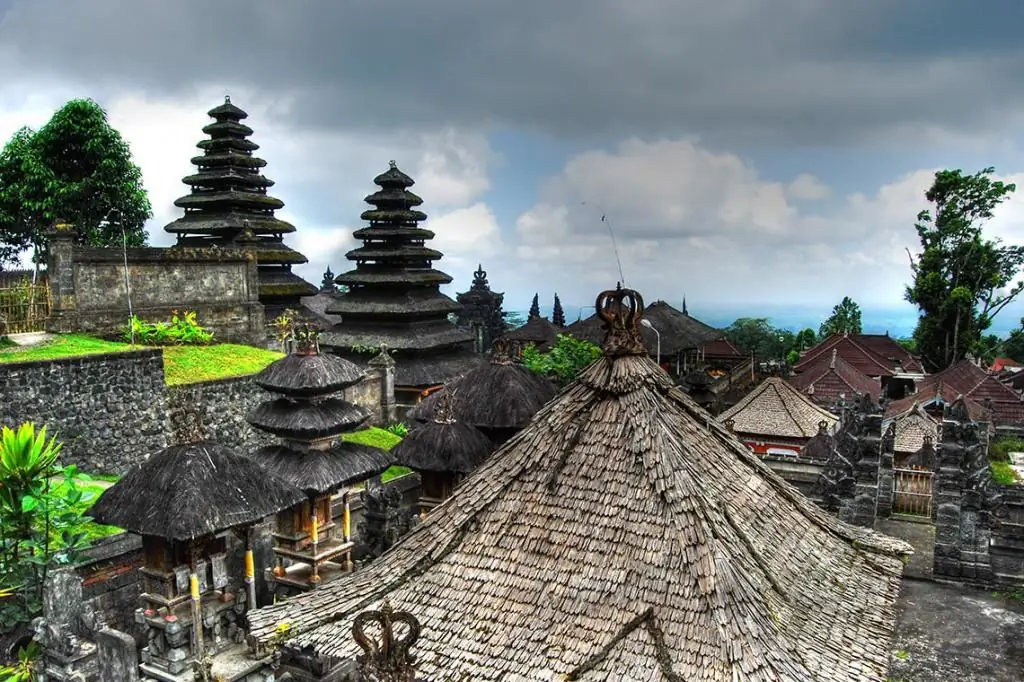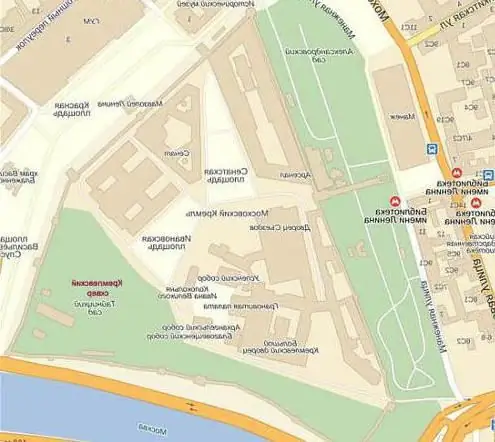- Author Harold Hamphrey [email protected].
- Public 2023-12-17 10:06.
- Last modified 2025-01-24 11:10.
Do you think that Old Believers in Russia can only be found beyond the Urals? Not at all! You can get acquainted with the patriarchal way of life of the Old Believers right in Moscow. To do this, you should go to Rogozhskaya Sloboda. It was once considered a suburb. In 1783, a road pole was installed there, where it was carved: “Two versts to Moscow.” However, now Rogozhskaya Sloboda is almost the center of the city. How to get there? What do you need to see in order to fully plunge into the Old Believer atmosphere of the priests? What temples are worth visiting? Our article will tell about it. But first, let's talk about the history of this settlement. She's pretty interesting.

The landing of coachmen
In Moscow, as in any other city, people who belonged to the same profession preferred to settle next to each other. Therefore, streets appeared under the name of "workshops": Myasnitskaya, Goncharnaya and so on. At the end of the sixteenth century inRussia has a new profession - the coachman. At first, these people delivered the sovereign's mail, they were messengers, but with their own "vehicle". Later, coachmen began to engage in other "carriage", delivering goods and passengers in different directions.
Soon there were so many of them that they were divided into routes. Those of them who specialized in traveling from Moscow towards the village of Stary Rogozhsky Yam settled on the outskirts of Belokamennaya, closer to the goal of delivering people and goods. These were the vicinity of the village of Andronikha, on the left bank of the Yauza. Later, the Old Rogozhsky Pit became the city of Bogorodsky, which was renamed Noginsk in Soviet times. And Rogozhskaya Sloboda, inhabited by coachmen serving this direction, has not changed its name. But the glory of the "holy land" remained with her.
Center of old inns
For a long time, all cities and even towns had fortress walls. In the middle of the eighteenth century, Moscow was encircled by the huge Kamer-Kollezhsky rampart, stretching for 32 versts. It got its name from the fact that there were outposts at different gates. They levied duties on imported goods. The Kamer-Collegium was in charge of this, which built the rampart. And this line of fortifications passed along the Rogozhskaya Sloboda. In the nineteenth century, the need for walls and ramparts disappeared. On the site of the old outposts, squares were formed, where fairs and markets were held on different days.
The most popular trading place was Rogozhskaya Sloboda, which stood on the big Vladimirsky tract. To arrive on time for the start of the fair, the merchantsarrived promptly. Where there is demand, there is supply. Sloboda began to be actively built up with inns, in modern terms, motels, where visiting merchants could stay without stopping by the city. Soon there were fewer coachmen's houses here. Along with the living quarters and warehouses, beautiful merchant houses appeared.

Old Believers
It just so happened that from the seventeenth century, that is, almost from the creation of the Rogozhskaya Sloboda, people excommunicated from the Russian Patriarchal Church began to settle in it. Old Believers-priests considered the new religion an apostasy and strictly adhered to their way of life. It left its mark on life. The old Rogozhskaya Sloboda, whose photos have almost disappeared, was a closed world, radically different from the rest of Moscow.
It was separated from the capital by the Yauza River. Along the long straight streets stood two-story stone houses on high foundations. Locked gates, rare passers-by - all this did not fit in so well with the turbulent boiling of life in Moscow … The newcomers did not stop here for a long time. Marriages were made only between fellow believers. In 1790, there were 20 thousand parishioners of the Old Believer Church, and in 1825 - already sixty-eight thousand.
New history of the settlement
For a long time this place was a kind of reservation. Muscovites from other parts of the city came to look at the Old Believer churches, the cemetery with bishops' graves and the tomb of the Morozovs and other dynasties. But gradually the wind of change also touched Rogozhskaya Sloboda. Wasthe Nizhny Novgorod railway was laid, putting an end to the unprofitable coach driver.
For a long time there was a stage (travel prison) in Rogozhskaya Sloboda. From here the convicts were sent into exile. They were lined up in rows - first convicts with shaved heads and leg irons, then those who were wearing only hand fetters, behind - simple settlers. The procession was closed by wagon trains, on which the wives and children of the exiles, as well as the sick rode.
In 1896 the station on Rogozhka was abolished. The line was extended to the Kursk railway station. Sloboda especially changed with the advent of Soviet power. And not only the streets were renamed. Many temples were destroyed, and new people began to settle on the streets. But there is still a touch of the patriarchal way of life in this area of Moscow.

Temples
The first Old Believer church was erected here at the beginning of the seventeenth century. It was wooden and was consecrated in honor of Sergius of Radonezh. In 1776, at the expense of merchants, a second church was built in Rogozhskaya Sloboda - St. Nicholas the Wonderworker. A big scandal broke out in the nineties of the eighteenth century. Then, at the expense of the Old Believer community, the architect Matvey Kozakov built a cathedral in honor of the Intercession of the Mother of God. It turned out to be not only more beautiful than the temples of the patriarchal church, but also larger than them. In size, it surpassed even the Assumption Cathedral in the Moscow Kremlin. This did not give rest to the clergy of the great church, who complained to Catherine II about the schismatics. And at the direction of the Empress, the Intercession Cathedral was "shortened." Were dismantled altar ledges, and out of the five cupolas of the dome, the Old Believers were allowed to save only one. Later, a winter (heated) Church of the Nativity of Christ, designed in pseudo-Gothic style, was erected nearby.

Cemetery and other significant places of Rogozhskaya Sloboda
In 1771 Moscow was covered by a plague epidemic. At the same time, the Old Believers asked the authorities for permission to equip a cemetery where they could bury fellow believers who died from pestilence. The place was chosen not far from the Vladimirsky tract. Even at the beginning of the 20th century, one could see an obelisk over the mass grave of the victims of the epidemic. But even when the plague receded, the cemetery continued to be replenished with new graves. Rich Old Believer families erected their family tombs here. The graves of industrialists and merchants Morozovs, Rakhmanovs, Soldatenkovs, Ryabushinskys, Shelaputins and others can still be seen in the cemetery.
Other significant institutions were also built at the expense of the community: the barrack-hospital appeared during the plague epidemic. Now it is a dental clinic. A wooden chapel appeared near the cemetery, which in 1776 was replaced by a stone church in Rogozhskaya Sloboda, lit in memory of St. Nicholas. A printing house for printing Old Believer books, an almshouse, an orphanage, and a teacher's institute were founded. In the latter, lectures were given by S. Bulgakov, A. Kizavetter, Prince E. Trubetskoy.
Historical and architectural ensemble
Neither under Catherine II nor under Alexander the First were the Old Believers persecuted. And thereforeMoscow Rogozhskaya Sloboda grew and was decorated with temples. The last church that was built here (St. Nicholas) was and remains "of the same faith." This means that priests recognized by the Russian Orthodox Church of the Moscow Patriarchate serve the liturgy here, but according to ancient rites and books.
This church was built on the site of an 18th century Byzantine-Russian chapel. Now the church of St. Nicholas is the only one in Moscow where all Orthodox can pray. In 1995, the Moscow government adopted a decree on the creation of a historical and architectural ensemble in Rogozhskaya Sloboda. The Gusev estate was to become the core of this cultural reserve.
Unfortunately, the plan for the restoration of some architectural monuments was canceled in 2011. However, the Church of Alexy in Rogozhskaya Sloboda, the Resurrection Bell Tower, the Intercession Cathedral and the cemetery Church of the Nativity, as well as the entire Rogozhsky village street, were declared cultural heritage sites.

Church of Alexy, Metropolitan of Moscow, in Rogozhskaya Sloboda
The first sacred building on this site was a small wooden church built in 1625. It fell into disrepair and at the very beginning of the eighteenth century was replaced by a brick building. The parishioners found the style of the church unsuitable. Funds were collected, and already in the middle of the 18th century it acquired a modern look.
The building was designed by Dmitry Ukhtomsky, choosing the late baroque architectural style for it. The temple was consecrated in the name of St. Alexis, Metropolitan of Moscow. This saintlived in the thirteenth century and was considered a miracle worker throughout Russia. The Metropolitan was canonized six months after his death.
The relics of the saint were kept and revered in various Moscow churches. Since 1947 they have been in the Elokhov Epiphany Cathedral. And the temple of Alexy in the Rogozhskaya Sloboda shared the fate of many sacred buildings in post-revolutionary Russia. In 1929, a warehouse and a repair and construction production workshop were arranged here. Restoration of the church began only in the 1990s.
What was and how the temple of Alexy looks now
The Old Believers used to order icons or buy old images and donate them to churches. And therefore, before the revolution, the church of St. Metropolitan of Moscow in Rogozhskaya Sloboda was a real museum. It contained icons of Novgorod and other famous masters, which date back to the 15th-16th centuries.
In the second half of the eighteenth century, the interior of the temple was complemented by amazingly beautiful wall paintings. After the revolution, church utensils were lost. The temple was destroyed, and only two tiers have survived from its bell tower. But the church is constantly undergoing restoration work. The main building was restored in 2012. Work is currently underway to restore the main exterior facade and the refectory.

Services
The Church of St. Alexis in Rogozhskaya Sloboda is located at the corner of Malaya Alekseevskaya and Nikoloyamskaya streets. It is easily recognizable by the red and white walls and the golden dome on the restored bell tower. This is currentlythe church is assigned to the temple of St. Sergius of Radonezh.
Ongoing restoration work does not interfere with worship. Liturgy is held on Saturdays and Sundays at 10:00. After it, at noon, a prayer service for pregnant women is performed. Divine services are also held on church holidays. Women come here who would like to have children. Prayers "for the gift of children" are served in the church building. The patronal holidays of the Church of Alexy of Moscow in Rogozhskaya Sloboda are: February 25 (new style), March 27, May 22, June 2, August 11 and 29, December 19.

Pokrovsky Cathedral
We have already mentioned this church, which, both in size and in decoration, turned out to be higher and richer than the temples of the Kremlin. At a time when the authorities favored the Old Believers, it was only "shortened", making it lower by a meter from the Assumption Cathedral. But even in this form, the Church of the Intercession of the Virgin at the Rogozhsky cemetery haunted the main Christian denomination in Russia.
In the summer of 1856, Metropolitan Filaret of Moscow ensured that the altars of the Old Believer churches in the capital were sealed. Only with the reforms of 1905, which proclaimed freedom of religion, the churches were returned to the community of priests. In honor of the unsealing of the altars, the church-bell tower of the Resurrection of Christ was built.
After the revolution, they wanted to close the Intercession Cathedral, but it was almost the only church in Moscow that continued to function as a temple. This happened partly because the building, built in the style of classicism, did not at all resembleto a sacred building. Only the only dome on the roof betrayed the church in it.
But the church-bell tower of the Resurrection of Christ was closed in 1930. You should pay attention to its facade. It is decorated with images of the mythical birds of Paradise - Sirin, Gamayun and Alkonost. The closed Church of the Resurrection of Christ did not last long. Services there resumed in 1947.
Temple of Sergius of Radonezh
This church, although more modest in size, is not inferior to the Intercession Cathedral in terms of decoration, collection of vestments and ancient icons. They say that when Napoleon approached Moscow, the priest of the temple, Sergius of Radonezh, ordered that priceless church utensils be buried in the cemetery. The invaders were told that the freshly dug up earth was nothing but the graves of those who died from the plague. The French were afraid to check whether it was true or not.
Before the revolution, the temple was famous for its wonderful choir of the blind. But what the French did not do, the local lumpen did. In 1922, more than five pounds of silver valuables were taken out of the church. What the barbarians could not steal, they chopped with axes and burned in bonfires. So many ancient icons and notes for the blind were lost. Workshops and a warehouse were housed in the church building. This caused great damage to the structure.
Only in 1985 it was transferred to the Museum of Ancient Russian Culture. A. Rubleva. To accommodate the exposition of icons, restoration work was carried out in the temple. Since 1991, the Russian Orthodox Church has owned the church of St. Sergius of Radonezh in Rogozhskaya Sloboda. The schedule of services in it is simple. Liturgy is celebrated daily at8:00 AM except Mondays.
Services are much more often held in the Old Believer Cathedral of the Intercession of the Virgin. On weekdays, the liturgy is performed at 7:30 and 15:30. On the eve of the holidays, a service is held at 14:00. On Saturday, the morning liturgy begins at seven, and on Sundays at half past seven.
Rogozhskaya Sloboda: how to get there
The Old Believer settlement is located between Aviamotornaya, Rimskaya, Marxistskaya and Taganskaya metro stations. Walking is the shortest way from the first two subway stops. Public transport runs from other stations. So, from Marxistskaya you can get to Rogozhskaya Sloboda by bus routes 51 and 169. Trolleybuses No. 26, 63 and 16 run from the Taganskaya metro station. former Voitovich).
It should be said that this village is interesting not only for its temples. There is an Old Believer cuisine restaurant, church shops, a folk costume workshop, Sunday religious schools for children and adults.






